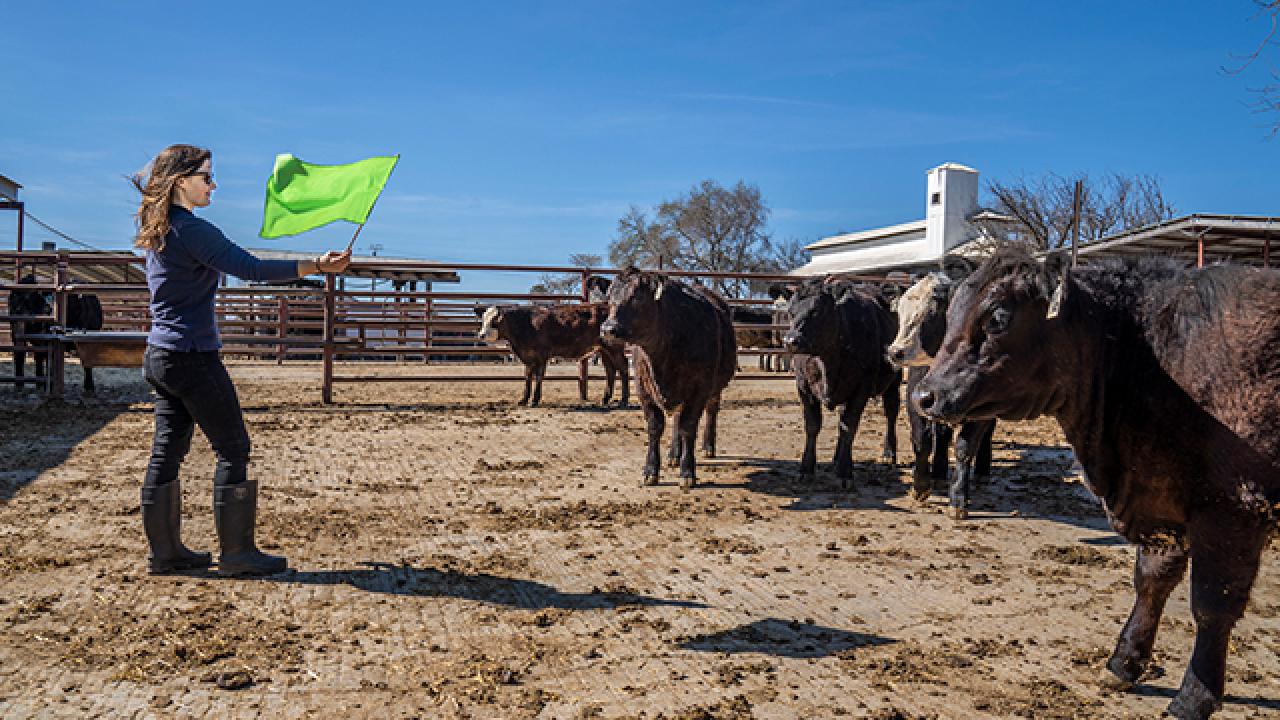
Nomads and Commuters
Understanding cattle personality may help keep rangeland productive, sustainable
Do you ever wonder why sometimes one, lone cow stands munching grass on a hillside while her fellow cattle graze in groups below?
Animal behavior experts at UC Davis do, and their curiosity may shed light on one of the most critical economic and ecological questions in rangeland management. How can we encourage more cattle to roam?
“Cattle distribution on ranches is a huge issue,” said Assistant Professor Kristina Horback, a CA&ES animal-cognition expert. “When cattle gather and graze by creeks, it can lead to overgrazing in riparian areas and let perfectly good forage go to waste. Tools like fencing can help, but could understanding animal behavior be part of the equation?”
Horback and a team of CA&ES researchers recently received $110,000 from the Russell L. Rustici Rangeland and Cattle Research Endowment to examine how cow personality impacts cattle distribution. This pioneering science can support efforts to breed for hill-climbing cows by correlating personality traits with certain behaviors like the inclination to roam.
Horback has studied animal cognition in several species of mammals, including elephants, chimps, prairie dogs, dolphins and whales. She is currently one of the few scientists in the world exploring the role personality plays in the welfare and sustainable production of farm animals like cattle, sheep and pigs.
“There’s been a lot of work done with wildlife personality and foraging preference, but virtually nothing with cattle,” Horback said. “We know with deer, birds and even insects that their level of boldness can impact the risks they take and how far they range for food. Do those instincts still apply in animals like cows that have been domesticated and bred for other traits for thousands of years?”
First up: Designing tests
To assess a person’s personality, psychologists rely on self-reporting surveys like the Myers-Briggs Type indicator. Since Horback can’t interview cows, she and her team set up situations that let cattle show their true colors.
“We’ll conduct startle tests,” explained Maggie Creamer, a Ph.D. animal behavior student who is working with Horback. “We begin with cows in a complacent state by offering food and then startle them with light, sound or vibration. We then measure their degree of recoil and latency to return to the food. Do they stay away from the spot or shake it off and continue eating?”
Because even cows can have a bad day, the researchers repeat the test at a later date.
“Maybe it was hot and the cow wasn’t feeling well,” Horback said. “We have to make sure the tests tell us something consistent about that animal.”
With input from California ranchers, Creamer and Horback are weighing the most relevant way to startle a cow. Remote-control snakes? A blast of noise?
“We’re playing with the idea of launching a drone,” Creamer said.
Researchers are also looking at sociability. They will separate a cow from the herd and see how quickly she wants to return to the group. Some cows seem fine with spending time alone.
When designing animal-personality tests, there are always a few kinks to work out. For example, the team is also measuring cattle response to novel foods to see how willing they are to investigate. Creamer conducted a few trial runs with carrots.
“When we offered the cows carrots in a feed pan, they were so startled by the pan that they stayed away from what was inside,” Creamer said. “So, we tried putting carrots directly on the ground in their pens, and they just trampled them.”
The GPS connection
The team will begin tests with about 40 adult females this summer. The first tests will be conducted at UC Davis and then move to the 5,700 rolling acres at the UC Sierra Foothill Research and Extension Center northeast of Sacramento.
“We’ll attach GPS collars to see how certain personalities correlate to habits on the range, like how far cows travel from water and their elevation gain,” Creamer explained.
Call them nomads and commuters. The team predicts the bolder cows will tend to be “nomads,” more willing to wander and take high risks for high rewards. The more cautious creatures may be “commuters” who prefer to dine closer to home.
Nomads might be a better match for ranches on steep, rugged terrain. Commuters may be fine for flat, open ranges. “Or maybe it’s the mix of personalities that works best,” Creamer said.
Horback and Creamer are working with several fellow researchers, including UC Davis Cooperative Extension Specialists Leslie Roche, Tina Saitone and Ken Tate, as well as UC Cooperative Extension Advisors Morgan Doran, David Lile and Tracy Schohr. The team is collaborating with California ranchers, who have volunteered their land for further tests.
“Ranchers are helping us make sure the tools we develop are useful,” Horback said. “At the end of the day, we want to provide information that can support good rangeland management.” •